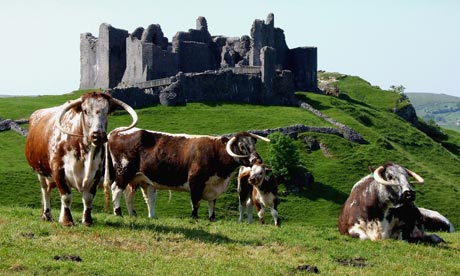
Iron Wales flat, and it would be bigger than England, yet it's the country's bumpiness that makes it so mysterious: all those crests and crannies to explore. Its man-made and natural wonders are inexhaustible. There is an old Welsh rhyme about the Seven Wonders of Wales, and the places it lists are well worth a look. But it seems designed to lure tourists to the country's north-east corner. Snowdon excepted, they are situated in a part of Wales not renowned for its beauty but, largely, they read like a list of day-tripper's wonders.
The anonymous writer of the rhyme offers a fairly pedestrian choice; Pistyll Rhaeadr is awesome, yes, but why wish depopulation on Snowdon? The fierce and clannish inhabitants of that highland help make it the odd and fascinating place it is. Still, it works as a nursery rhyme, a mnemonic to help children remember that they live in a country of wonders, or as a blurb on a postcard to send to the folks back home. Indeed, it's something of a wonder itself, given that its author is unknown, and its date is debatable. And it serves a useful purpose, in that it galvanises Cymrophiles into compiling a list of their own alternative seven, and here's mine, mostly man-made, mostly coastal; from marsh to mere, beach to pinnacle, Wales has its marvels.
From the south, start at St Govan's chapel, close to Bosherston. A tiny stone structure on the beach, at the base of sheer cliffs. Over 1,000 years ago St Govan, on the cliffs above, was assaulted by first-millennium hoodies. But the cliffs opened and enfolded him in protection, so he chose this spot for his grave. This maternal fissure can be seen inside the chapel.
Further up the coast, just past the wee cathedral city of St David's, lie the twin villages of Porthgain/Abereiddy, linked by a cliff walk. The beach hamlet of Abereiddy contains a sea pool coloured luminous blue by mined minerals (this area was once central to the country's slate and lime and brick-making industries), often brought in by seals. Porthgain possesses huge disused dock works, brick kilns and hoppers for crushed rock - intriguing and incongruous, in this small village. It has a great pub in The Sloop Inn (01348 831449, sloop.co.uk) and a brilliant fish restaurant in The Shed (01348 831518, theshedporthgain.co.uk).
Head inland for Llandeilo, outside of which you'll find Carreg Cennen Castle, one of the most majestically imposing castles in Britain. Forget Harlech, Beaumaris, Conwy, splendid as they are; Carreg Cennen sits on a huge and looming outcrop of rock, its towers shimmering in mist and circled by soaring buzzards, wheeling and squealing. Built in 1248, it fell to the English in 1277, during Edward I's first murderous foray. There's a cave in its walls that will take you deep into the guts of the vast limestone plinth; turn your torch off, and try not to scream.
Head for the Ceredigion coast now, to Mwnt and its minuscule whitewashed church, dating back to the sixth century. Flemish raiders landed here in 1155, only to be roundly trounced by the locals. The pasture here still disgorges human bones. Inland again, into the extensive rural hinterlands of Ceredigion, what the late Harri Webb - poet, activist, journalist, essayist, polemicist - called "the green desert". You won't find a lot of people in these uplands, but you'll find much evidence of their passing: many megaliths on the hill-flanks and roadsides, the ancient Roman fort at Llanio, near Tregaron, and the disused mine excavations, near Craig y Pistyll, whose subterranean pump still works, thumping the hill's heartbeat into your feet; Nant-y-Moch reservoir in the Rheidol valley, near Aberystwyth, site of the rebel Glyndwr's greatest victory, when the archers of the English army, chosen for their Welsh heritage, turned around and launched their arrows at their "own" men.
Into the far north now, to Nant Gwrtheyrn on the Llyn peninsula, at the vertiginous foot of Yr Eifl, burial place of Vortigern, who betrayed his Celtic brethren and invited the Saxons in. You can hear him spinning in his grave now, as the rows of isolated cottages here host residential courses for Welsh language learners. It's a beautiful, remote spot, full of ruins and rusting landing-craft and nature trails and blue seas to swim in. Tre'r Ceiri - "town of the giants" - sits on the mountaintop above: prehistoric remains, with 150 stone huts protected by house-high ramparts. The view, and the wind, will plunder your breath.
On to Anglesey, or Ynys Mon; the island itself is a wonder. The church of St Dwynwen, the Welsh St Valentine; the eerie red moonscape of Parys mountain; henges and cromlechs. St Siriol's Well: a friend dipped his head in it once and, for the rest of the day, was blessed with astonishing fortune, which allowed him to fleece me at pool in a pub in Llangefni. A minute past midnight he fell ill with gastroenteritis. This is a truly wonderful country.
The poem
Pistyll Rhaeadr and Wrexham
Steeple,
Snowdon's Mountain, without
its people;
Overton Yew Trees,
St Winefride's Well,
Llangollen Bridge and
Gresford Bells.
And Niall's version:
St Govan's chapel and
the church at Mwnt;
The middle green desert,
and Gwrtheyrn at Nant.
Castell Carreg and Porthgain
and the mad flat land of
Ynys Mon.

